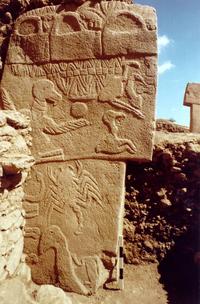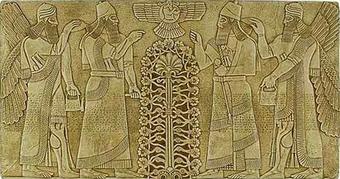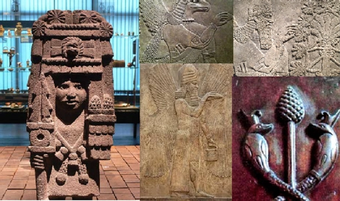Decoding the Night Sky

Watch: Ancient Babylonian Astrology
Imagine a world where the night sky is a glowing cuneiform text of symbols that tell a story. We can read the words written by our ancestors in stars that will guide us on our journey through life.

It is a world where lions sit in repose, guarding the horizon. One looks east and the other looks west. They protect the mountain where the sun will set, before it is resurrected in the east.
Opening the gate to the underworld, are two guards, half man and half scorpion. These night watchmen protect the tunnel where the sun will make its transformation and rebirth.
Those called to descend will meet a winged goddess, wearing a feather and surrounded by birds. She is in charge of cosmic order, crouching and guiding the sun on its underworld journey.

And if you are from a culture that doesn’t have mountains you make them. These resurrection vehicles for kings will follow the sun on the same journey.
These are our symbols and they capture the power of our Mountain, our goddess and the sun.
This land of phoenix birds and underworld creatures describe a circular journey, curated by a goddess who can teach us about the lightness of being.
"The joy of living should make the heart equal to the weight of a feather – because our Ka or spirit is being measured."

To traverse the heavens and travel through the underworld, our scorpions have wings, and our serpents have feathers.
10,000 years will pass before they discover what we carved onto our stones.
They will say they are vultures playing with skulls because they don’t understand. They cannot know the power of our mountains, ziggurats, the scorpion, our crouching and winged goddess and her birds.

They don’t understand the sacred ibis, and why our creatures sit in repose. It takes time for a transformation to occur.

But we carved three bags at the top so that they might remember.
"To understand us, you must decode the night sky.
We are the Babylonians – and we can read the stars."
Astrology is a way of exploring the evolution of the human imagination, and what ultimately became its myths and religions. We can use it to peer both, forward and backward in time. The night sky connected cultures across great distances because we were observing the same stars. By decoding the night sky – we can understand the world the way the ancient’s viewed it.
The starry sky has always captured our imagination as a place of wonder and inspiration. Even today, we can trace the same celestial highway, and observe the cast of characters as planets and constellations that gave rise to the many stories that shaped our earliest beliefs.
We are also seeing the light of stars that took tens of billions of years to reach the earth. On that scale, looking back thousands of years to understand what the ancients wrote about astral phenomena is like reading a postcard sent to us, just a few days ago.
Long before the Greek’s were translating Sumerian words into myths, the Babylonian’s were cataloguing the stars. In fact, today, we are discovering how many Greek stories, such as Perseus, Medusa, and the Hydra came from the way cuneiform script can have several meanings. Most of our myths can be traced to celestial phenomena described by the Sumerians and perhaps, older and unknown cultures.
In the same way the modern bible was consolidated, rewritten and re-interpreted over the many centuries, what we read about Astrology today, is a homogenized and watered-down version of more ancient story.
The Mesopotamian Valley is one of the first agricultural civilizations and while Astrology was born in this region, zodiac signs can be found in petroglyphs at Gobekli Tepe and Ratnagiri that date back to 10,000BC.
Babylonian Astrology developed around 1250 BC, but the Sumerian names of their star catalogue reveal how people were decoding the night sky during the Bronze age.

Prior to migrating to Canaan, Abraham was said to be a Magi who came from Ur in the Mesopotamian region. We can see in this image that this culture also represented the journey of the sun as a phoenix with two lions looking east and west. The Egyptians calculated the location of planets using methods originating in Babylonia. Our original archetypes have the same roots, but our politics have shaped them into different narratives.
We actually find the flood story and tower of babel in the Epic of Gilgamesh from Sumerian tablets.
The ancients believed that activity in the heavens was a precursor to what will happen on the Earth.
The Magi or ummânu could forecast events by watching the planets and stars, as a way of interpreting the divine. Each constellation had a story to tell and each planet was a god. As the planets moved from one constellation into another, their patterns of behavior gave each their distinct characteristics.

We can apply this practice in modern times. The planet Uranus is associated with technological advances and Pisces embodies the melting pot of civilization. It moved through Pisces from 2003 to 2011 when technology and online shopping dissolved the old world of bricks and mortar.
We can only wonder what the pandemic would have been like had we not moved to an online world. In this way, the behavior of ‘deities,’ or planets through the constellations, guide humanity.
Whether in Egypt, Babylon, or Meso America, pyramids were built to observe the equinoxes and solstices. Star alignments allowed the ancients to predict the onset of the rainy season, important for the management of these budding agricultural societies. Like the mountain and resurrection vehicle for the sun and kings – these monuments allowed the ancients to follow the movement of the sun.

Each of these cultures also portrayed deities carrying square bags which is puzzling. However, knowing that all of the characters of our mythologies originated in the sky, we can look to the constellations for an answer.
The Babylonians viewed the fourth Quadrant of the zodiac, home to Capricorn, Aquarius and Pisces, as an area called ‘the Sea.’ The deities they called Apkallu or wise ones, were associated with each of these constellations. These ‘fish men’, or sages who were said to have come from the sea, bringing enlightenment to humans, were enacting something in the heavens, not on Earth.
If your job was to watch and predict the appearance of celestial events, you would notice that the planets move differently against a backdrop of fixed stars. Egyptians watched for the Dog Star Sirius to signal the inundation of the Nile. The Olmec watched Quetzalcoatl as Venus, the Feathered Serpent, beginning its underworld journey.
The behavior of Venus gave rise to the stories about Persephone abducted into the underworld by Hades. Venus inspired tales of a rising bird and underground snake, called Kukulkan in Mayan myths.
The snake worshipping rituals of many ancient cultures was tied to rebirth because the snake shed its skin in cycles. It became the psychopomp of the underworld and held the secrets of immortality, healing and rebirth. The snake constellation Ophiucus was also located at the celestial equator, which represents a type of rebirth for the cosmos. In Babylonian Astrology, this constellation was called the Sitting Gods and Ningishzida was a snake deity who guarded Anu’s celestial palace.
In ancient times, Venus was actually called Lucifer, bearer of light. This ‘imposter of the Sun’ was not an evil deity. When Isaiah wrote “Lucifer, who has fallen” he was comparing the king to Venus who falls below the Earth in recurring cycles. It disappears from view because it is in between the Earth and the Sun.
Archeologists can only make sense of their discoveries by understanding the movement of the planets and constellations. Virtually all ancient cultures kept some form of astrological records on monuments, which has aided archeologists in dating artifacts.
This form of early record keeping aligned the power of kings with the heavens. In the same way, Astrology reveals a similar ‘hero’s journey’ in each and every chart.
The Sumerians interpreted the night sky like a language emanating from the gods. The Sumerian word MUL can mean both ‘star’ and ‘inscription.’ Cuneiform is a wedge-shaped script that can look angular, much like stars. To the scribes, the constellations, stars and planets would have appeared as the illuminated writings of the gods. The Magi and ummanu were simply writing what they saw in the sky.
Astrologers do this each time they look at a chart. The glyphs, lines, signs, planets and houses might not make sense to the untrained eye, but astrologers read it as an unfolding story of what a client came here to accomplish.

In this image, we see the original tree of knowledge under a symbol of the phoenix-like, renewing sun god with the wise ones acting as intermediaries. The Magi held visionary gifts that allowed them to interpret the sky like a glowing form of cuneiform text. One points to the divine, while the other points to the tree. Like an Astrology chart, this tree, developed as the Sephirot of Kabbalah.
Malkut is that place where receptive potency can distribute the divine stream as it flows to the lower worlds. This Sephira embodies the oral and spoken law or how those on the earth translate an understanding of the divine.
The winged Apkallu, carry the same bags we see in so many artifacts. The ancients may have called the area of Capricorn, Aquarius and Pisces the Sea because it rained when the sun is in these signs. Each of these signs was associated with one of the 3 main deities: Anu, Enlil and Enki. The three bags at Gobekli Tepe may signify this more ancient trinity.
The square nature of the bag is sometimes called a water bucket, or thought to be a battery from the ancient world. Others describe it as the gifts of civilization or shamanic tools given to humans. However, if we can see the sky the way that the ancient’s saw it – we might be able to decode the meaning of these bags. Virtually everything that was carved into ancient monuments represented celestial events.
The ancients believed the Earth was stationary and surrounded by an arc or firmament that had planets and stars attached to it. Today, we know it is the earth that is turning. Because the deities would spend time climbing mountains, and dipping below the earth into primal seas, many were depicted with fish or water imagery.

The constellation of Pisces straddles a large square in the sky that was and still is – used as a starting point when mapping the heavens. Each star is 15° degrees apart, and make a square with sides that run parallel to the celestial meridians. It was called MUL IKU, a word that means Field. Today, we know it as the Square of Pegasus.
Additionally, Babylonian Astrologers called the Perseus constellation Sibu or Old Man, and saw it as part of this square. Sibu was associated with the path of Anu the oldest and highest god. Sibu also means Elders, officials, and those who witness omens. Since the ancients believed their ancestors, the immortals and the gods lived in the sky or came from the Sea, the ‘Old Man’ sitting in a square might allow us to understand how a square relates to enlightenment.
The Greek writer, Hesiod, also described how Pegasus came from the Sea. He used the multiple meanings for Sumerian words like horse and cut off head, when writing about Medusa in this area of the sky. His Perseus was the realm of the Sumerian Apkallu.
We can begin to see how something we carry, like a bag can represent both the Apkallu’s hidden wisdom written in the stars, and the ummânu’s ability to read them. The square is where the oldest divinities live, and the arc is the Sumerian understanding of the cosmos.

Additionally, the bags are often paired with pine cones. Named after the pine cone, the pineal gland regulates sleep and dreams.
In the book of Job, we are told: ‘when we sleep, when we dream, in a vision of the night, then our ears are opened.”
Pine trees can also represent the eternal that doesn’t die away, because they remain evergreen.
The Sumerian names for the stars and constellations of this region, reveal words like Sea, Swallow, Whale and even how the sea engulfed humanity. In this way, the flood may have been an event that occurred in the heavens, and not on earth.
What is most puzzling about the Vulture Stone at Gobekli Tepe is not the bags, but how they pre-date the period in which we believe astrology developed.
An astrologer, like the ummanu doesn’t use reason when interpreting a chart – they activate vision and read the glyps like a language. It may be that our understanding of the stars came to us from dreams, or a part of the mind that was accessible before the development of language – and how our critical faculties overwhelm us.
These societies who turned to the heavens over vast millenniums and over great distances, have left us this package of wonder. Have we suffered collective amnesia? Is there truth to how the stars can guide us? What did the ancients read in the skies?
In my book, Decoding the Night Sky: Ancient Babylonian Astrology, I examine each of the 12 zodiac signs from a world that predates the Greek interpretation. This book not only allows us to understand the signs, planets and houses more in depth, it explores the evolution of human ideas.
